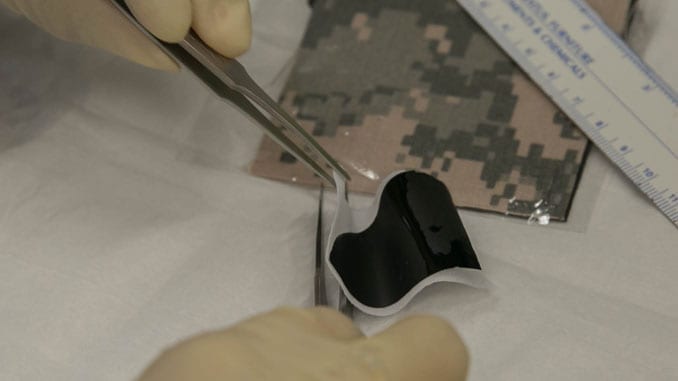
A team of scientists at Lawrence Livermore National Laboratory, backed by the Defense Threat Reduction Agency, has created a material that is highly breathable yet protective from threat agents.
The team fabricated flexible polymeric membranes with aligned carbon nanotube (CNT) channels as moisture conductive pores. The size of these pores (less than 5 nanometers, nm) is 5,000 times smaller than the width of a human hair.
To provide high breathability, a critical requirement for preventing heat-stress and exhaustion, the new composite material takes advantage of the unique transport properties of carbon nanotube pores. By quantifying the membrane permeability to water vapor, the team found for the first time that, when a concentration gradient is used as a driving force, CNT nanochannels can sustain gas-transport rates exceeding that of a well-known diffusion theory by more than one order of magnitude.
“We demonstrated that these membranes provide rates of water vapor transport that surpass those of commercial breathable fabrics like GoreTex, even though the CNT pores are only a few nanometers wide,” said Ngoc Bui, the lead author of paper the team published recently in the journal, Advanced Materials.
Blocking Viruses and Bacteria
These membranes also provide protection from biological agents due to their very small pore size — less than 5 nanometers (nm) wide. Biological threats like bacteria or viruses are much larger and typically more than 10-nm in size. Performed tests demonstrated that the CNT membranes repelled Dengue virus from aqueous solutions during filtration tests. This research confirms that LLNL-developed CNT membranes provide effective protection from biological threats by size exclusion rather than by merely preventing wetting.
Furthermore, the results show that CNT pores combine high breathability and bio-protection in a single functional material.
Chemical Threat Responsiveness
Chemical agents are much smaller in size and require the membrane pores to be able to react to block the threat. To encode the membrane with a smart and dynamic response to small chemical hazards, LLNL scientists and collaborators are surface modifying these prototype carbon nanotube membranes with chemical-threat-responsive functional groups.
These functional groups will sense and block the threat like gatekeepers on the pore entrance. A second response scheme also is in development — similar to how living skin peels off when challenged with dangerous external factors. The fabric will exfoliate upon reaction with the chemical agent.
“The material will be like a smart second skin that responds to the environment,” said Kuang Jen Wu, leader of LLNL’s Biosecurity & Biosciences Group. “In this way, the fabric will be able to block chemical agents such as sulfur mustard (blister agent), GD and VX nerve agents, toxins such as staphylococcal enterotoxin and biological spores such as anthrax.”
“These responsive membranes are expected to be particularly effective in mitigating a physiological burden because a less breathable but protective state can be actuated locally and only when needed,” said Francesco Fornasiero, LLNL’s principal investigator of the project.
The new uniforms could be deployed in the field in less than 10 years.


